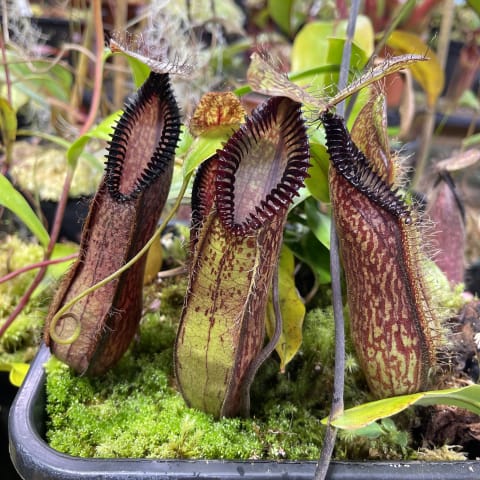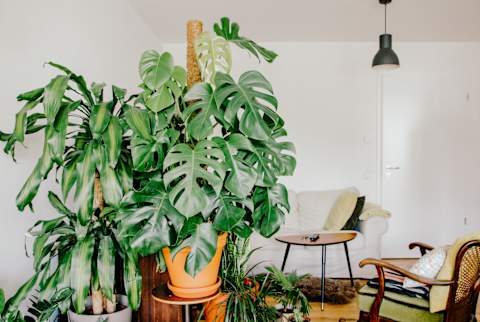
Our editors have independently chosen the products listed on this page. If you purchase something mentioned in this article, we may earn a small commission.
January 14, 2022 — 12:03 PM
As far as low-maintenance houseplants go, the Chinese evergreen is a standout thanks to its unique leaf pattern and ability to thrive in lower light conditions. Native to the rainforests of Asia, Chinese evergreens can now be found throughout the world, in many colors and shades. Here’s how greenery experts recommend caring for the resilient plant.
Chinese evergreen (Aglaonema) plants are native to Southeast Asia and the Pacific Islands, explains Lindsay Pangborn, a gardening expert at Bloomscape. “These plants evolved in humid, tropical rainforests, growing along the forest floors in dappled shade,” Pangborn tells mbg.
People started bringing them inside and keeping them as houseplants—ones that could survive in darker parlor rooms, at that—around the Victorian era. Over time, Chinese evergreens have been bred to take on bright shades like hot pink (Aglaonema Creta), and today, you can find many varieties of the plant in offices, shops, and residences that don’t get a lot of bright light, as well as in tropical gardens.
You can usually spot a Chinese evergreen by its leaves: They’re long, with a strong vein running down the middle and a speckled pattern along the sides.
“Because of their tolerance for both moist and dry conditions, and the fact that they will tolerate low light, they are a perfect choice for less than ideal light conditions or forgetful plant owners,” says Pangborn.
While it isn’t the fastest-growing plant out there, Chris Satch, a plant specialist at Horti, has found that Chinese evergreens can get up to 3 feet tall when properly cared for. With time, it can also spread outward and grow up to 3 feet wide.
- Sunlight needs: Medium to low light
- When to water: When soil is dry to the touch
- Pros: Tolerates low light, unique leaf pattern
- Cons: Slow to grow, toxic to pets
- Where to put them: In full shade (outdoors) or in a spot that gets 1 to 4 hours of direct light (indoors)
- Pet-friendly? Toxic to cats and dogs according to the ASPCA
- Size: Can grow up to 3 feet tall by 3 feet wide
Different varieties of Chinese evergreen.
Many varieties of Chinese evergreens are now available in nurseries and plant shops. Here are some of the popular ones Pangborn sees around the most:
- Aglaonema ‘Cutlass’: Silvery leaves with dark green edges and veins
- Aglaonema ‘Suzy’: Mostly green with some soft pink speckling
- Aglaonema ‘Creta’: Medium green leaves with hot pink edges and veins
- Aglaonema ‘Red Gold’: Similar to Creta, but with red coloration instead of pink
- Aglaonema ‘Silver Queen,’ ‘Silver King,’ and ‘Emerald Bay’: These all have a similar look with silver and green variegated leaves
- Aglaonema ‘Harlequin’: Green, yellow, and pink variegated leaves
Planting & growing a Chinese evergreen.
probiotic+
Tackle your gut issues now, so you don’t have to think about them later.*

If you live in a hot climate (USDA cold hardiness zones 10, 11, and 12), this perennial should be happy in your garden year-round. Live in a cooler area? You can place your Chinese evergreen outside at the height of summer, but you’ll need to bring it inside once temperatures dip below 55 degrees or so, says Pangborn, as it’s not frost-tolerant.
“If planting outdoors, make sure to keep it in full shade,” adds Satch. He finds that the plant makes for great ground cover in places that don’t get a lot of foot traffic, like shaded alleyways.
Since this plant thrives in shadier conditions, you won’t want to place it in the brightest spot in your home. Instead, Satch recommends looking for a spot that gets a maximum of one to four hours of direct sun a day.
“Because they’re so easygoing, Aglaonemas are perfectly suited for a modern living room or office, dim bedroom, or cozy study,” says Pangborn. “They will also do well in a bathroom since it’s also a room with low light and will benefit from the added humidity.”
Here’s how to keep your hardy Chinese evergreen happy with the right amount of water, light, and heat.
Pangborn recommends giving your Chinese evergreen plant a good soak when about 50% of its surrounding soil is dry. This will likely mean watering it every one to two days if it’s outdoors in the hot sun and slightly less frequently during the cooler months.
If you’re keeping it as a houseplant, water your Chinese evergreen when the first few inches of soil feel dry to the touch: “Every five to 10 days depending on how much light/heat the plant is getting,” says Satch. If you’re struggling to know when to water your plant, check out this helpful guide.
“Water slowly to allow water to soak into the potting soil until it flows through the drainage hole at the bottom of the pot,” says Pangborn. “Discard any water that accumulates in the saucer.”
“Your Aglaonema prefers a humid environment,” says Pangborn. “Group your plant near others or use a pebble tray to increase humidity.”
You can also place your plant in a steamy bathroom, next to a humidifier, or near any of these other DIY tools that’ll increase your home’s moisture.
As mentioned earlier, Chinese Evergreens can survive in lower light conditions—but that doesn’t mean you should relegate them to a pitch-black room! Place them in a spot that gets at least a few hours of bright light a day to help them grow strong.
You’ll know you’ve gone overboard and they’re getting too much sun if their leaves begin to fold upward or develop spots that look scorched or bleached. If that happens, move them farther away from the nearest window.
This plant can stand the heat, and it’ll thrive in conditions up to 85 degrees Fahrenheit, says Satch.
If temperatures dip much below 60 degrees Fahrenheit, the plant might get too cold and its leaves will begin to brown and curl around the edges. Avoid placing your Chinese evergreen too close to a drafty window or air conditioner.
“Aglaonema like a well-draining soil that retains a bit of moisture—any general-purpose houseplant potting soil will be perfect,” Pangborn says. “Fertilize once a month during the spring and summer with a liquid fertilizer for indoor plants.”
Since it’s a relatively slow grower that prefers to be slightly root-bound, you shouldn’t need to transfer your Chinese evergreen to a larger pot more than once every two to three years.
When you notice that your plant’s roots are growing out of its pot’s drainage hole, that’s a sign it could use some more space. Here’s a primer on how to give it a new home when the time comes.
Common problems & how to fix them.
If you notice your Chinese evergreen starts to look yellow, droopy, or otherwise sad, here are some potential causes:
- Drooping leaves: A drooping plant is likely too wet or too dry. “Feel the soil to figure out which,” says Satch. Since they’re pretty resilient, Chinese evergreens will usually bounce back from underwatering and slight overwatering very quickly.
- Leaf drop: It’s normal for this plant to drop some of its older leaves from time to time, says Satch. But if you notice that many leaves are dropping all at once, it’s likely not getting enough sunlight. Move to a brighter spot for a few weeks and see if that helps.
- Dry leaf tips or leaf edges: Pangborn notes that these can indicate dry air or cold stress. “Increase humidity, and be sure your plant is somewhere warm without drafts from nearby windows, doors, or air conditioning vents,” she recommends.
- Yellow leaves: “Yellow leaves could be any stressor,” says Satch. “Check the temps, water, light, fertilizer, drafts, heaters, etc., to figure out which is the cause.” This guide to diagnosing yellow leaves can help.
As they get older, Chinese evergreens grow by producing underground shoots called pups, making them easy to propagate. Once the pup has grown two to three leaves of its own, you can separate it from its parent plant and grow it in its own pot. This is called a division propagation method, and here’s how it’s done:
- It’s best to propagate at the start of the growing season in early spring. Gently shake your plant out of its pot.
- Find where the pup meets the rest of your plant and pull. If your pup doesn’t break apart from the rest of your plant on the first try, you can also use scissors or a knife.
- Shake soil off the pup’s roots, making sure that they are healthy enough to be planted on their own. (They should be light in color and strong to the touch).
- Transfer your pup to a small new pot that has well-draining soil.
- Keep its soil nice and moist for the first few weeks, then begin to water and care for your plant baby as normal.
Division tends to be the easiest method, but Chinese evergreens can also be propagated using a stem-cutting technique (more on that here). And Satch adds that since some Chinese evergreen plants eventually flower, they can be pollinated and propagated by seed, too—though the process is more involved and can take up to a year or longer.
If you’re looking for your next plant pal, Chinese evergreen plants, or Aglaonemas, make for a wonderfully chill houseplant or garden addition. Just make sure to give them enough heat and humidity and don’t overwhelm them with too much sun.
Want to learn how feng shui can help you create a high-vibe home and set powerful intentions to manifest your dreams? This is feng shui the modern way – no superstitions, all good vibes. Click here to register for a free session with Dana that will give you 3 tips to transform your home today!








